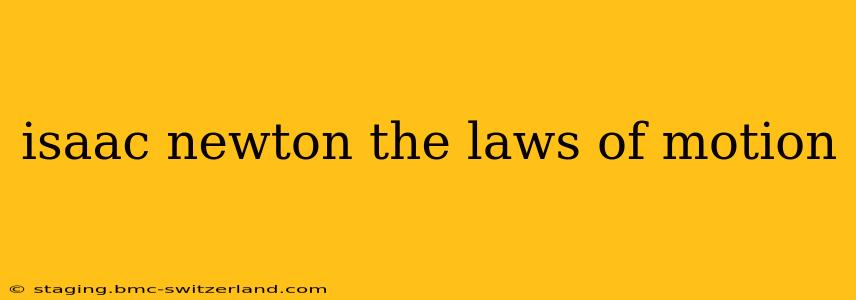Sir Isaac Newton's Laws of Motion are cornerstones of classical mechanics, forming the bedrock of our understanding of how objects move. These three concise laws, published in 1687 in his Principia Mathematica, revolutionized physics and continue to be essential for understanding everything from the trajectory of a baseball to the orbits of planets. This article will delve into each law, explore common misconceptions, and answer frequently asked questions.
Newton's First Law of Motion: Inertia
Newton's First Law, also known as the law of inertia, states: An object at rest stays at rest and an object in motion stays in motion with the same speed and in the same direction unless acted upon by an unbalanced force.
This seemingly simple statement has profound implications. Inertia is the tendency of an object to resist changes in its state of motion. A stationary object will remain stationary unless something pushes or pulls it. Similarly, a moving object will continue moving at a constant velocity (speed and direction) unless a force intervenes. This force could be friction, gravity, or any other external influence.
Think of it this way: Imagine a hockey puck gliding across frictionless ice. Without any external forces acting upon it, it would continue sliding in a straight line at a constant speed forever. The reality, of course, is that friction eventually slows the puck down.
What is an unbalanced force?
An unbalanced force is a net force that is not equal to zero. When multiple forces act on an object, they are added vectorially. If the resultant force is zero, the forces are balanced and the object's motion will not change. If the resultant force is non-zero, it is an unbalanced force that will cause a change in motion.
Newton's Second Law of Motion: F = ma
Newton's Second Law defines the relationship between force, mass, and acceleration: The acceleration of an object is directly proportional to the net force acting on the object, is in the same direction as the net force, and is inversely proportional to the mass of the object. Mathematically, this is represented as F = ma, where:
- F represents the net force (measured in Newtons)
- m represents the mass of the object (measured in kilograms)
- a represents the acceleration of the object (measured in meters per second squared)
This law explains how forces cause changes in motion. A larger force will produce a larger acceleration, while a larger mass will require a larger force to achieve the same acceleration.
How does mass affect acceleration?
Mass is a measure of an object's inertia – its resistance to changes in motion. A more massive object requires a greater force to achieve the same acceleration as a less massive object. Think of pushing a shopping cart versus pushing a car – the car, having significantly more mass, will require much more force to accelerate at the same rate.
Newton's Third Law of Motion: Action and Reaction
Newton's Third Law states: For every action, there is an equal and opposite reaction. This means that whenever one object exerts a force on a second object, the second object simultaneously exerts a force equal in magnitude and opposite in direction on the first object.
These forces are always paired and act on different objects. They are never acting on the same object. Consider the act of jumping: you push down on the Earth (action), and the Earth pushes up on you with an equal and opposite force (reaction), propelling you upwards.
Are action and reaction forces always equal and opposite?
Yes, absolutely. This is a fundamental principle of Newtonian mechanics. The forces are always equal in magnitude and opposite in direction. The difference in the resulting motion of the two objects is due to their differences in mass. For example, when you jump, you exert a force on the Earth, and the Earth exerts an equal force on you. However, the Earth's immense mass means its acceleration is negligible, while your much smaller mass results in a noticeable upward acceleration.
Frequently Asked Questions
What are some real-world examples of Newton's Laws of Motion?
Examples abound! Driving a car (acceleration, braking, turning), playing sports (hitting a ball, throwing a javelin), riding a bicycle (balance, acceleration), and even walking all demonstrate Newton's Laws in action. The flight of an airplane is a complex interplay of all three laws.
How do Newton's Laws apply to rockets?
Rockets are a perfect example of Newton's Third Law. The rocket expels hot gases downwards (action), and the gases exert an equal and opposite upward force on the rocket (reaction), propelling it into space. Newton's Second Law governs the rocket's acceleration, as the thrust (force) determines the acceleration, influenced by the rocket's mass.
Are Newton's Laws always accurate?
Newton's Laws are remarkably accurate for everyday situations and many macroscopic systems. However, they break down at very high speeds (approaching the speed of light) and at very small scales (the quantum world). Einstein's theory of relativity and quantum mechanics provide more accurate descriptions of motion under these extreme conditions.
This exploration of Newton's Laws of Motion provides a foundational understanding of classical mechanics. While these laws might seem simple at first glance, their implications are far-reaching and fundamental to our comprehension of the physical world. Further study will reveal the elegance and power of these foundational principles.
